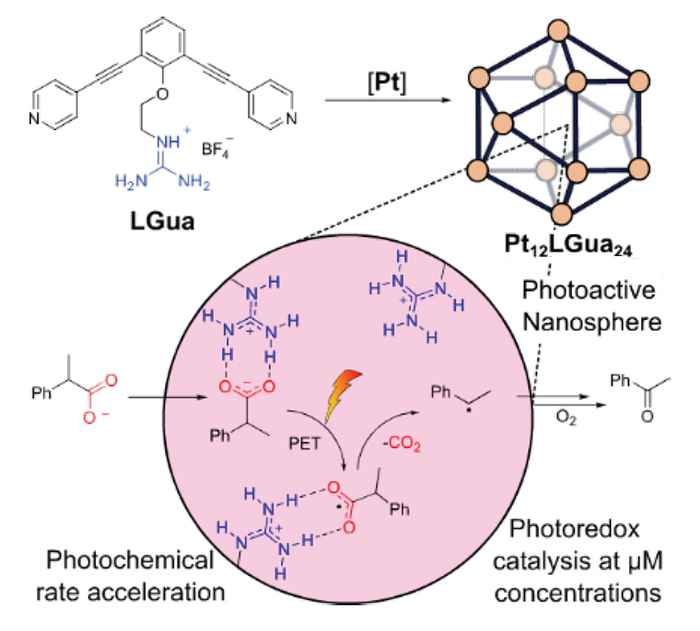Accelerating decarboxylation catalysis through substrate preorganization in photoactive self-assembled nanospheres
3 June 2025

The researchers at the Homogeneous, Supramolecular and Bio-Inspired Catalysis group led by Prof. Reek equipped Pt12L24 nanospheres with guanidinium moieties to enable the preorganization of carboxylic acids in the nanospheres. These nanospheres act as photocatalysts for the decarboxylation reactions.
Efficient photoredox catalyis
Photoredox catalysis is increasingly important in the field of sustainable synthesis. However, such reactions are fundamentally limited by the lifetime of the photo-excited state and the concentration of the substrate that reacts with the excited state. In their paper in Angewandte Chemie, the researchers describe a strategy to bypass these limitations, by substrate preorganization in the nanosphere cavities, leading to high local concentrations of up to 1M.
This pre-organization allows efficient photoredox catalysis at concentrations as low as 2 µM, even though the lifetime of the photoexcited state of the used catalysts is 1000 times shorter than an earlier reported iridium based catalyst. In addition, the pre-organization effect also leads to acceleration of the photochemical reaction rate by two orders of magnitude, which is generally beneficial for the development of sustainable chemical reactions.
Abstract, as published in the paper
Photoredox catalysis with short-excited state lifetimes or in dilute conditions is challenging because the photochemical mechanism relies on collisions within the excited state of the photocatalyst. In this work, we use substrate preorganization within Pt12L24 nanospheres as strategy to perform photoredox catalysis at low concentrations. We show that Pt12L24 nanospheres are efficient photocatalysts for the decarboxylative oxygenation reaction. Nanospheres endo-functionalized with guanidinium groups (Pt12LGua24) pre-organize the substrate, which increases the catalytic turnover frequency by two orders of magnitude. Crucially, this preorganization ensures that Pt12LGua24 retains its photocatalytic activity at extremely low concentrations (2 μM). This strategy thus overcomes the concentration limitations of photoredox catalysis and may be interesting for applications in dilute environments such as water purification and cellular photocatalysis.
Paper details
Rens Ham, Joost Reek, Bettina Baumgartner: Substrate Preorganization within Photoactive Pt12L24 Nanospheres for Accelerated Decarboxylation Catalysis at Low Concentrations. Angew. Chem. Int. Ed. 2025, e202508131 DOI: 10.1002/anie.202508131
See also
Research group Homogeneous, Supramolecular and Bio-Inspired Catalysis